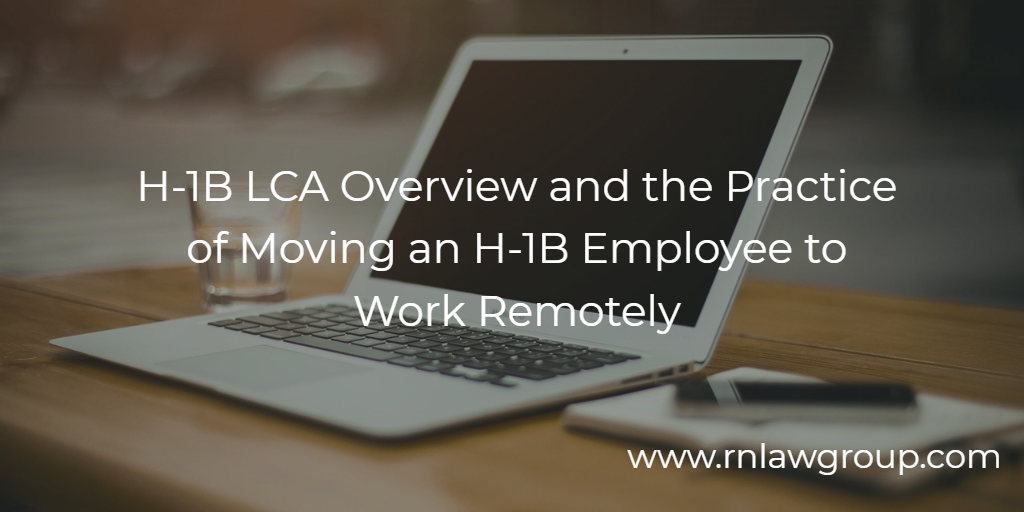
H-1B LCA Overview and the Practice of Moving an H-1B Employee to Work Remotely
The year 2020 brought a lot changes to the world as we knew it. The usual way of life that many of us had grown to take for granted was suddenly changed in ways that were initially inconceivable. Notably, the way businesses operated changed dramatically as offices moved to nearly 100% remote work. With this adjustment now seemingly becoming the status quo for the foreseeable future, a question about how this pivot to remote works affects recipients of work visas is at the forefront of the immigration legal community.
This article aims to address this question but, specifically, addresses the issue as it concerns H-1B visa recipients who may now be asked to work remotely.
H-1B and LCA
Every year, the United States allows for up to 65,000 H-1B applications for new beneficiaries seeking temporary employment in America under what is known as the H-1B cap. In addition to the 65,000 that is already earmarked, an additional 20,000 are available to individuals who have earned a U.S. master’s degree or higher. For all of those 85,000 annual recipients, in addition to the typical hiring documents such as an I-9, prior to beginning work, their employer must file and have approved a Labor Condition Application (“LCA”).
A LCA is an application that is filed on behalf of H-1B, H-1B1, or E3 visa employees. The LCA will state information such as job title, salary, anticipated length of employment, and whether or not any other non-immigrant workers will be hired at the same time. Generally, the LCA also contains four attestations from the employer that are factual statements that are supported by evidence. The four attestations are:
- The employer must provide that the non-immigrant worker will be paid the same or better wages and benefits that they pay to another employee doing similar work in their geographic region;
- The employer must attest that the hiring of the non-immigrant work will not adversely affect the working condition of similarly employed workers and, of those working conditions, the conditions for the non-immigrant worker are similar to those of their native U.S. counterparts;
- The employer must attest that there is not a strike, lockout, or work stoppage at the employment location the day the LCA is filed. Additionally, they must also attest that if such a lockout were to occur, they will notify the Department of Labor Employment and Training Administration (“DOLETA”) within three days of the incident occurring;
- The employer must attest that as of the date of the LCA, they will provide notice of the application to the other workers in the company
Per DOLETA regulations, an employer must notify any employees of the possible hiring in the open positon by clearly posting the notice in two locations at the workplace for at least ten (10) days. Additionally, they must also notify any employee bargaining representatives of the hiring and must provide a copy of the LCA with the non-immigrant employee.
While all four of the attestations are important, for the purposes of remote work, the fourth attestation is the most important. DOLETA regulations state that an employer who submits a LCA also must mention a place of business on the application. The place of business requirement includes both long and short terms work locations. There are roughly three types of worksite locations that can be used to fill in the application:
- Place of Employment- the physical location of your office
- Temporary or short term work location- any place where your employer will work for less than five consecutive days in a week
- Working at client site-location – any other location where the employee may end up working
Department of Labor (“DOL”) guidance defines a place of employment, for purposes of an H-1B, as the “worksite or physical location where an H-1B nonimmigrant worker actually performs his or her work.” DOL guidance further states that an LCA “must be filed for the geographic area where an employer intends an H-1B worker to be employed.” This guidance then goes on to define a “geographic area of intended employment” as “the area within normal commuting distance of the place (address) of employment, or worksite, where the H-1B nonimmigrant is or will be employed.”
If an employer is seeking to have their employee work remotely in a new geographic area of intended employment, for example changing states, a new LCA is required unless this work assignment meets the criteria of short-term placement. Under USCIS guidance, if you make a move that requires a new LCA, you are required to file an amendment H-1B as well. However, if an employer wishes to have their H-1B employee work remotely and wherever the employee will be then working from is within a normal commuting distance of the already listed work place, there is no need for adding a new work location to the LCA.
If the employee will be working from home as a primary work location the employer must list the address of the employee’s home as an additional work location. Furthermore, much like with any other location, the employer must also show that the employee will be paid a similar or higher wage to someone else in that position doing similar work in that geographic location as well.
Remote Work
When an employer wishes to hire a non-immigrant employee to work on a remote basis, they must follow all the regulations concerning the filing of a LCA. This includes even following the posting requirement even if the employee will be working from their own home for whatever reason that is deemed necessary.
Just like with any other work location, if an employee will be working remotely at their home, the LCA must still be posted for a total of ten days at the location prior to them beginning to be able to work. If the individual will be working remotely at a home, the notice can be placed on any entrance or doorway. If the individual will be working from an apartment, the notice may be placed communal bulletin or notice boards.
As noted above, there are different LCA requirements if the move meets the criteria of short-term placement. If the move to remote work is merely temporary, as many changes were originally believed to be at the beginning of the pandemic, DOLETA permits that a H-1B employee may be placed to work at a site that has not be listed on an approved LCA for up to thirty (30) days. This work may be extended for up to sixty (60) days in a one year period so long as they can show that the new worksite has ties to the main worksite the non-immigrant employee was originally to work at. Moreover, the employer will also be tasked with paying for the non-immigrant workers cost of lodging, travel, meals, incidentals, and other miscellaneous expenses. This are mandatory payments in order to comply with the short-term placement provisions.
However, any time longer than the allowed sixty days will trigger the new for filing an amended LCA to show the new worksite as an additional worksite.
While this is a very general overview of the process that is involved in having a H-1B non-immigrant worker work remotely, there are many potential issues that you may run into as you attempt to onboard your employee. Thus, we believe that it is important to speak to a qualified business immigration attorney to assist you in the preparation and filing of your paperwork to help reduce the chance of a denial. If you have any questions regarding this process or are in need of guidance in how to best comply with USCIS regulations, you can set up a consultation with any of our Reddy Neumann Brown PC attorneys.
By: Steven Brown

